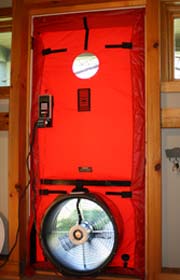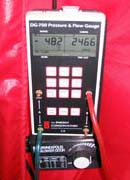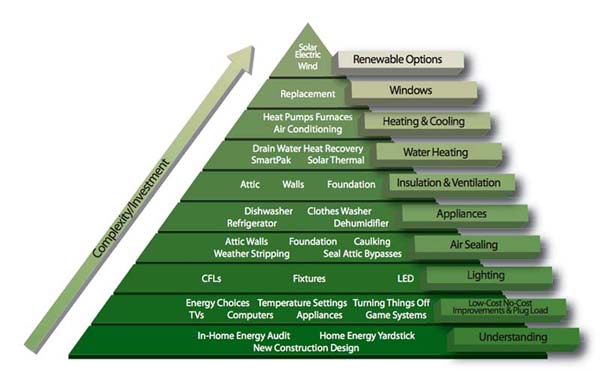The Audit Process
 An energy audit for your home is the first step to reducing energy consumption and costs. By using specialized equipment and performing a thorough inspection we can give you a detailed view of your homes' energy use and concrete steps to curb your energy consumption. Residential energy use accounts for approximately 12% of total energy usage in the United States. Reducing the energy usage of homes can put a significant dent in the amount of energy we use as a country.
An energy audit for your home is the first step to reducing energy consumption and costs. By using specialized equipment and performing a thorough inspection we can give you a detailed view of your homes' energy use and concrete steps to curb your energy consumption. Residential energy use accounts for approximately 12% of total energy usage in the United States. Reducing the energy usage of homes can put a significant dent in the amount of energy we use as a country.
In our energy audits we look at two basic aspects of your home, insulation levels and air infiltration. These two factors largely determine the energy levels needed for heating and cooling your home. The majority of homes today leak large amounts of conditioned air out of the house while at the same time allowing outside air to come into the conditioned space. This, coupled with inadequate insulation levels, can cause huge energy bills and inefficient use of your home furnace or air conditioner.
Info Produced
 The primary tools employed in a home energy audit are the blower door and a thorough physical inspection of the home. A blower door is designed to fit an exterior doorway of the home and suck air our of the home to create a vacuum. The blower doors' instrumentation can then measure the air coming out of the house while allowing the inspector to check the house for areas of air leakage.
The primary tools employed in a home energy audit are the blower door and a thorough physical inspection of the home. A blower door is designed to fit an exterior doorway of the home and suck air our of the home to create a vacuum. The blower doors' instrumentation can then measure the air coming out of the house while allowing the inspector to check the house for areas of air leakage.
Air flowing out of the house gives us a measument of the ventilation rate measure in cubic feet per minute, or CFM. We can then check this number against a calculated minimum ventilation rate to see if your home is allowing too much air to exchange between indoor and outdoor air. A minimum ventilation rate is necessary to keep indoor air quality at an acceptable level.
The audit will also include an inspection of insulation in the house. Attics, walls, and foundation are inspected to see if adequate levels of insulation are present. This, combined with air leakage measurements, gives us a full view of what steps may be taken to make a home as efficient as possible.
Benefits
- Gives homeowner understanding of home energy usage and loss.
- Improvements outlined can bring savings to the homeowner and increase comfort levels in the home.
- Investments can be directed towards highest savings or homeowner priority.
- Develops a well defined course towards energy efficiency and conservation.
- Equips homeowner with ability to make some simple, low-cost improvments themselves.
Where to Invest
The dilemma of where to invest your money is one that all homeowners struggle with. Often times tangible and flashy home improvements are the ones that prevail. Added insulatation in the attic may not be as asthetically pleasing as new windows, but often it is the insulation that will reap more savings in the near and long term. We can help you determine where your money would best be spent and what improvements will have the best cost-to-investment ratio.
Indeed many efficiency improvements can easily be made by the homeowner while others require the help of a professional. EnergyStar and the EPA have produced a helpful do-it-yourself manual on weatherization available in both pdf and html versions. The pyramid below shows you the progression from low-cost simple improvements to more exprensive and complex energy saving measure that can be made to your home.

Energy-Efficiency Investment Pyramid
 An energy audit for your home is the first step to reducing energy consumption and costs. By using specialized equipment and performing a thorough inspection we can give you a detailed view of your homes' energy use and concrete steps to curb your energy consumption. Residential energy use accounts for approximately 12% of total energy usage in the United States. Reducing the energy usage of homes can put a significant dent in the amount of energy we use as a country.
An energy audit for your home is the first step to reducing energy consumption and costs. By using specialized equipment and performing a thorough inspection we can give you a detailed view of your homes' energy use and concrete steps to curb your energy consumption. Residential energy use accounts for approximately 12% of total energy usage in the United States. Reducing the energy usage of homes can put a significant dent in the amount of energy we use as a country.
 The primary tools employed in a home energy audit are the blower door and a thorough physical inspection of the home. A blower door is designed to fit an exterior doorway of the home and suck air our of the home to create a vacuum. The blower doors' instrumentation can then measure the air coming out of the house while allowing the inspector to check the house for areas of air leakage.
The primary tools employed in a home energy audit are the blower door and a thorough physical inspection of the home. A blower door is designed to fit an exterior doorway of the home and suck air our of the home to create a vacuum. The blower doors' instrumentation can then measure the air coming out of the house while allowing the inspector to check the house for areas of air leakage.


